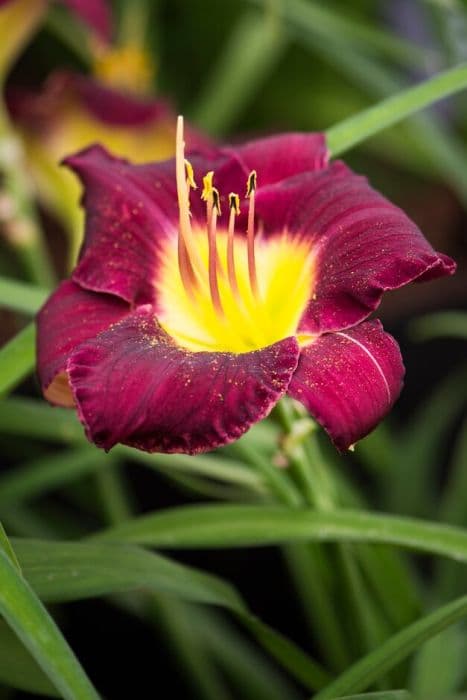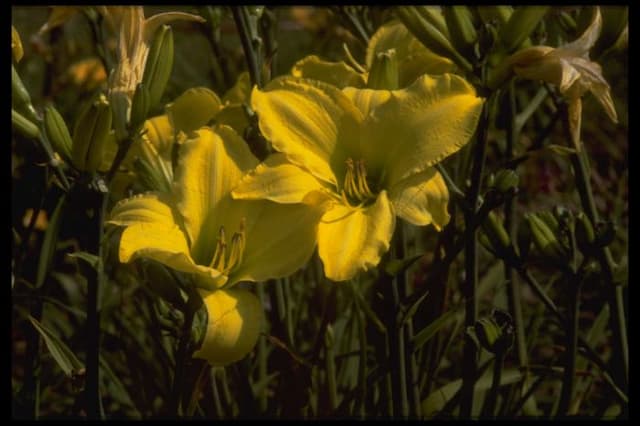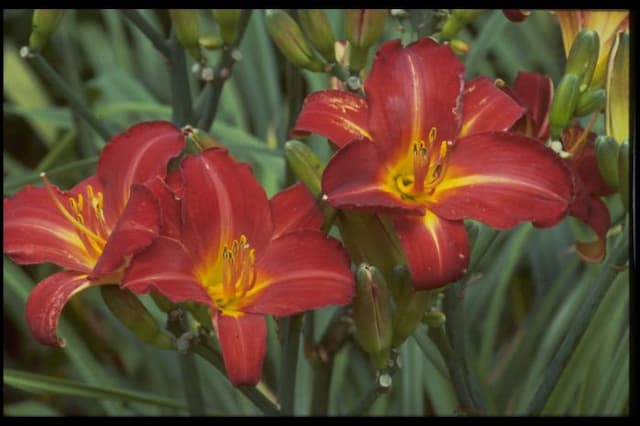Daylily Hemerocallis 'Garnet Lustre'

ABOUT
The daylily 'Garnet Lustre' is a captivating plant known for its distinctive blooms. The flowers are characterized by their rich, deep garnet red color, which gives the plant its name. These showy blossoms typically have a slightly ruffled edge and may exhibit a subtle sheen or luster, as suggested by the term "lustre" in its name. Each flower of 'Garnet Lustre' comprises six petal-like parts, with three outer sepals and three inner petals that usually display a symmetrical form. The blooms are carried atop sturdy, upright flower scapes that arise from a tuft of strappy, arching green leaves. These leaves form a lush and dense foliage that serves as a verdant backdrop to the spectacular flowers. At the center of each flower, there is a contrasting throat, often in a lighter shade such as yellow or green, which adds depth and dimension to the overall appearance. The flowers of the daylily 'Garnet Lustre' open up to reveal their full splendor during the day and typically last for just one day, hence the name "daylily". However, the plant compensates for this by producing a profusion of buds that ensure a successive and prolonged display of color throughout the blooming period. The daylily 'Garnet Lustre' is known not only for its aesthetic appeal but also for its resilience and adaptability, making it a beloved addition to gardens where it can be admired for its striking display of richly colored blossoms.
About this plant
 Names
NamesFamily
Hemerocallidaceae
Synonyms
Daylily, Common Daylily
Common names
Hemerocallis 'Garnet Lustre'.
 Toxicity
ToxicityTo humans
Daylily 'Garnet Lustre' is considered non-toxic to humans. In fact, some daylily species are known to have edible flowers. However, it is crucial to correctly identify the plant and ensure that it has not been subjected to any harmful pesticides or other chemicals before ingestion. If there is uncertainty regarding the species or treatment of the plant, it is best to avoid consumption as a precaution.
To pets
Daylily 'Garnet Lustre' is potentially toxic to cats and should be regarded with caution. In cats, ingestion of any part of the plant, particularly the flowers or leaves, may cause symptoms such as vomiting, lethargy, kidney failure, or even death if not promptly treated. Dogs are not typically affected in the same way; however, it's always prudent to keep an eye on your pet's behavior and consult with a veterinarian if you suspect ingestion and observe any health changes.
 Characteristics
CharacteristicsLife cycle
Perennials
Foliage type
Deciduous
Color of leaves
Green
Flower color
Garnet
Height
2 feet (60.96 cm)
Spread
2 feet (60.96 cm)
Plant type
Herb
Hardiness zones
Varies
Native area
Asia
Benefits
 General Benefits
General Benefits- Easy to Grow: Hemerocallis, commonly known as daylily, is renowned for its ease of cultivation, adapting well to a variety of soil types.
- Drought Tolerant: Once established, daylilies are quite drought tolerant, making them suitable for xeriscaping or drought-prone areas.
- Pest Resistant: Daylilies tend to have fewer issues with pests, reducing the need for chemical treatments in the garden.
- Long Blooming: The 'Garnet Lustre' variety, like many daylilies, has a long blooming period, often from early summer to fall.
- Attractive Flowers: This plant produces beautiful garnet-colored blooms that can enhance the aesthetic appeal of any garden or landscape.
- Low Maintenance: Daylilies require minimal care once established, making them an ideal choice for low-maintenance gardens.
- Erosion Control: Their dense growth habit can help stabilize soil and control erosion on slopes or in problem areas.
- Dividable: These plants can be easily divided to create more plants, making them cost-effective and great for sharing with fellow gardeners.
- Wildlife Attraction: The flowers of daylilies can attract pollinators like butterflies and bees, promoting biodiversity in the garden.
- Multifunctional: Daylilies are versatile and can be used in borders, as ground cover, or in containers, offering a range of landscaping uses.
 Medical Properties
Medical PropertiesThis plant is not used for medical purposes.
 Air-purifying Qualities
Air-purifying QualitiesThis plant is not specifically known for air purifying qualities.
 Other Uses
Other Uses- Edible Flowers: The flowers of the daylily can be eaten raw or cooked, often used in salads, soups, or fried as a snack.
- Natural Dye: The petals of Garnet Lustre daylilies can be used to produce natural dyes for textiles, yielding a range of soft orange to yellow hues.
- Companion Planting: The daylily can be planted among vegetables to attract pollinators and beneficial insects or used as a ground cover to suppress weeds.
- Water Filtration: Daylilies can be planted along the banks of ponds or in rain gardens to help filter and clean runoff water.
- Culinary Garnish: The vibrant Garnet Lustre blooms can serve as an elegant garnish for desserts and specialty cocktails.
- Pond Edging Plants: Their lush foliage and flowers make them well-suited for softening the edges of ponds, enhancing the natural appearance of water features.
- Erosion Control: The fibrous root system of daylilies helps to hold soil in place on slopes, preventing erosion.
- Craft Projects: Dried daylily flowers can be used in craft projects, such as potpourri or incorporated into homemade paper.
- Photography Subject: Their stunning appearance makes Garnet Lustre daylilies a popular subject for photographers and artists.
- Biological Pest Control: Planting daylilies can lure away pests from more sensitive plants, as they are hardy and have few problems with pests themselves.
Interesting Facts
 Feng Shui
Feng ShuiThe Daylily is not used in Feng Shui practice.
 Zodiac Sign Compitability
Zodiac Sign CompitabilityThe Daylily is not used in astrology practice.
 Plant Symbolism
Plant Symbolism- Perseverance: As part of the daylily family, Hemerocallis 'Garnet Lustre' blooms for just a day, symbolizing the resilience and perseverance required to make the most of every moment.
- Motherhood: In Chinese culture, daylilies, in general, are a symbol of motherhood and fertility, representing the nurturing aspect of mothers and the cycle of birth and rebirth.
- Forgetfulness: The ephemeral nature of its flowers, which last only a single day, can also symbolize forgetfulness and the fleeting nature of memory.
- Longevity: Daylilies have a robust and hardy nature. Despite their individual flowers' short lifespan, the plants themselves are long-lasting, symbolizing long life and good health.
- Rebirth and Renewal: The daily blooming cycle of Hemerocallis 'Garnet Lustre' signifies renewal and the opportunity of new beginnings.
 Water
WaterDaylilies, the common name for Hemerocallis 'Garnet Lustre', prefer consistent moisture, so it's best to water them deeply once a week, providing about an inch of water each time. During hot and dry conditions, increase watering to twice per week, ensuring the soil stays moist but not waterlogged. In cooler, wetter climates, you might only need to water every ten days to two weeks. Use a soaker hose or drip irrigation to deliver water directly to the roots, and avoid overhead watering which can lead to leaf spot diseases. An average-sized daylily plant typically requires between 0.5 to 1 gallons of water per week depending on the weather and soil conditions.
 Light
LightDaylilies thrive in full sun to light shade. The ideal spot for the 'Garnet Lustre' variety is in a location that receives at least six hours of direct sunlight each day. However, in extremely hot climates, they benefit from light afternoon shade to prevent the colors from fading and to reduce stress on the plants.
 Temperature
TemperatureDaylilies are hardy and can tolerate a wide range of temperatures; however, they grow best when daytime temperatures are between 60°F and 75°F. They can survive minimum winter temperatures down to -20°F and are heat-tolerant in summer up to 90°F or higher. Providing the ideal temperature range encourages vigorous growth and optimal blooming.
 Pruning
PruningDaylilies benefit from pruning to remove spent flower stalks and promote rebloom. After blooming, cut back the flower stalks to the base to keep the plant looking tidy and to potentially encourage a second flush of flowers. Prune away any dead or yellowing foliage throughout the growing season to maintain the health and appearance of the plant. The best time for major pruning, such as removing old foliage, is in late fall or early spring.
 Cleaning
CleaningAs needed
 Soil
SoilDaylilies, including 'Garnet Lustre', thrive best in slightly acidic to neutral soil, with a pH of 6.0 to 7.0. The ideal soil mix should be rich in organic matter, well-draining, and fertile. A mix of two-thirds loam and one-third compost or well-rotted manure creates an optimal growing medium. Mulching can help maintain moisture and soil fertility.
 Repotting
RepottingDaylilies are not commonly grown in containers and thus do not require frequent repotting. They are perennial plants often grown outdoors in gardens where they can spread through their root system. If grown in a container, repotting every 3 to 4 years or when crowded can be sufficient.
 Humidity & Misting
Humidity & MistingDaylilies, including 'Garnet Lustre', are adaptable to a wide range of humidity levels and do not require specific humidity conditions. They are tolerant of both dry and humid climates, making them suitable for different garden environments without the need for humidity control.
 Suitable locations
Suitable locationsIndoor
Ensure ample light and potting mix with good drainage.
Outdoor
Choose sunny spot, enrich soil with compost, water regularly.
Hardiness zone
3-9 USDA
 Life cycle
Life cycleThe life of the daylily 'Garnet Lustre' begins with germination from seed, though it's more commonly propagated by division of its tuberous roots. Once established, the plant emerges in early spring with strap-like foliage, forming a dense clump. By mid-to-late spring, flower scapes grow, leading to the blooming period in early summer, where each 'Garnet Lustre' blossom lasts only one day but is replaced by others in a series of blooms over several weeks. After flowering, the plant sets seed pods if pollination occurs, though daylilies are often sterile or the seeds don't come true to the parent plant. As summer ends, the plant begins to enter dormancy, with foliage dying back in response to cooler temperatures. Daylilies typically require minimal care through winter, surviving in a dormant state, and will re-sprout the following spring to repeat their life cycle.
 Propogation
PropogationPropogation time
Early Spring
The Hemerocallis 'Garnet Lustre', commonly known as the Daylily, is best propagated by division, which is typically done in late summer to early fall. This process involves carefully digging up an established clump of daylilies and using a sharp spade or knife to divide the clump into smaller sections, each with a few fans of leaves and a portion of the roots. The divisions should then be replanted at the same soil depth they were originally growing and watered thoroughly. This ensures that each division has ample time to establish its root system before the onset of winter, leading to a robust growth in the following spring. Division helps to rejuvenate older clumps that may have become overcrowded and also allows gardeners to multiply their daylily plants efficiently.









